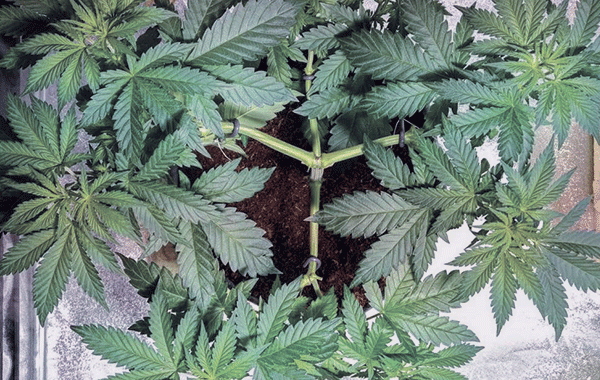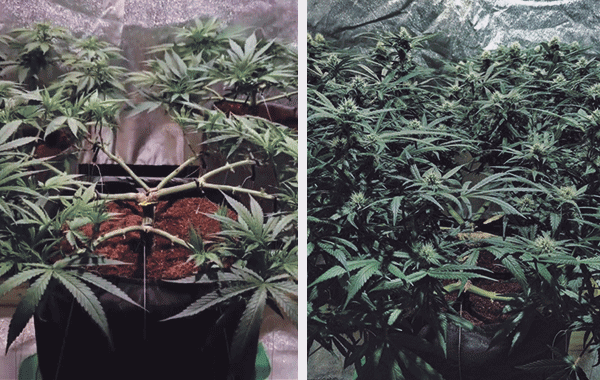How to Main-Line Cannabis
Published :
Apr 16, 2019
Categories :
Cannabis cultivation

Who doesn't want bigger, denser buds and a faster trim? If you main-line your cannabis plants, that's what you'll get in addition to a bigger overall yield. This training method takes a bit more upfront work than other techniques, but it's not difficult to do. Read this guide to learn how to main-line and why it works.
The main-lining technique is an advanced training method that encourages your plants to form an even canopy for uniform colas and maximum light penetration. If everything works to plan, the extra upfront work will translate into a substantially bigger yield by the time you reach harvest.
WHAT DOES MAIN-LINING MEAN?
Main-lining cannabis plants creates a manifold system using the stems and branches of your plant. A manifold has one inlet and multiple outlets. Think of it like a splitter for a TV signal.
The main trunk of your plant forms the inlet. You will create the outlets as you top the plant to create more branches. Then, using multiple types of training methods, including bending and tying the plant, you'll form the plant into a symmetrical network of colas with an even canopy, so that each top has uniform growth and bud development. When done correctly, there will be little, if any, popcorn buds.
Main-lining will give you results as good as ScrOG (Screen Of Green), but without nearly as much effort. You do all the prep work early in veg and only make minor adjustments as the plant grows. Eliminating the nets has significant advantages too. It's much easier to water and flush your plants—or just move them around if you need to.
HOW TO USE THE MAIN-LINING TECHNIQUE
SUPPLIES
- Cannabis seeds
- Clean razor
- Plant-safe wire or ties
- Plant cage
We recommend that you grow from seed if you want to try main-lining. It's possible to main-line clones, but it's harder to get the symmetrical nodes this technique requires. As plants become more mature, they naturally create asymmetrical nodes, and clones are always at the same level of maturity as the mother at the time when the cuts are taken.
You can make your own plant cage from heavy wire or modify one from a garden shop. They're commonly used to support tomatoes and other high-yielding vegetable and flower plants. For main-lining, you'll only use the bottom ring and the support legs.

STEPS
1. GERMINATE YOUR SEEDS
Start your seeds using your preferred method. Allow them to grow until they have at least 5 nodes, then transplant into their final pot.
2. START BUILDING THE MANIFOLD—1 INTAKE, 2 MAINS
Top your plant at the 3rd node. Make a straight cut and don't FIM. Remove all vegetation above and below the 3rd node. Leave the 3rd set of growth tips and leaves intact.
You'll now have the main shoot (the manifold intake), two branches and enough leaves to generate energy for your plant so it will continue to grow. The two branches, or growth tips, will form the main pipes into the manifold.
Gently bend the two branches down on opposite sides of the plant until they form at least a 90° angle and tie them down. If they're not long enough to tie down, allow them to grow for a couple of extra days first. They can be tied or clipped to the main stem or to the side of the pot. The support ring will be too tall to use at this point.
Make sure that the material you use to tie down the young mains does not break their skin. If you don't have ties or wire designed to support plants, use a heavier gauge wire. Coat hangers or pipe cleaners will work, but avoid very thin wire or string.
Don't be alarmed if it looks like you've stripped your plant of almost all its vegetation. It's supposed to look like that and the plant will recover quickly now that it is directing all its energy to the single set of growth tips that remain.
3. DOUBLE THE MAINS—1 INTAKE, 4 MAINS
As each main recovers, it will reach towards the light. The stem will lengthen and new leaves will grow. If left at this point, the plant would have two colas, but each one would fight for dominance. One would probably win and be visibly bigger than the other, and you'd still have weak lower branches with larfy popcorn—exactly what we're trying to avoid.
New nodes should be growing on each of the two existing mains in mirror-image fashion. Choose a matching pair on each side, making sure they're spaced an equal distance from the plant's trunk.
Top each node on both mains leaving the growth tips intact. Keep the fan leaves directly below each growth tip, but remove all other vegetation below them, all the way down to the plant's trunk. This funnels all the plant's energy to the four mains.
Once the new mains are long enough, tie them down like you did with the original two.
4. REPEAT STEP 3 UNTIL YOU HAVE ENOUGH MAINS
If four mains, meaning four colas, are enough, you can stop here. If you'd like more, repeat step 3 until you're satisfied with the number.
Each time, top all of the current mains at nodes that are the same distance from the trunk, so that everything is uniform. That means that you'll double the number of mains each time going from 4 to 8 to 16 to 32 to 64.
Most indoor growers stop at 8 colas and outdoor growers top to 16 or 32 tips. If you'd like to combine main-lining with ScrOG, 32 to 64 mains should be your goal.
Main-lining will increase the overall yield compared to many other training techniques, but don't go overboard. At some point, you'll reach the maximum capacity of your growing environment and your genetics. When you go past the point where you can increase the total weight, you'll only distribute it across more colas and end up with smaller buds.
5. ADD THE PLANT CAGE
After you finish making new mains, give the plant time to recover. Once each main is growing toward the light, install the cage and tie each main to the ring. This will give your plant a uniform shape and allow the light to penetrate through the canopy so that the top buds don't put the lower ones in too much shade.
At this point, most of the work is done, but you still need to watch the main stems in case one shows a dominant growth pattern. If that happens, gently bend it or tie it down until the tip is slightly lower than the next tallest cola. Sometimes, you can slide the wire attaching the cola to the ring, so that it's at an angle that makes it shorter.
6. REMOVE THE INITIAL TIE-DOWNS
Once the manifold is established, the stems will get woody enough that they retain their shape, so the initial tie-downs will no longer be needed. Remove them so they don't cause any damage as the plant grows.
7. PREPARE TO BE ASTOUNDED BY WHAT MAIN-LINING CANNABIS CAN DO
The majority of your work is now over, so you'll be able to relax, feed your plants and enjoy the show as they start to bloom. If you've main-lined properly, you'll be more than satisfied with both the final yield and overall bud density.
As a bonus, main-lined buds have a high calyx to leaf ratio, so they're really easy to trim, cutting down the time to manicure by as much as 75% in some cases.
THE SCIENCE BEHIND MAIN-LINING CANNABIS
Main-lining works in ways that are clear to see. The even canopy lets plenty of light reach even the lower buds so that shade is minimized, but there's another reason why main-lining delivers optimal results.
Cannabis plants that tend to have a single, large cola do so because of a trait called apical dominance. The plant naturally favours the cola that's closest to the light and sends the majority of its nutrients to that branch. If something happens to that branch, the plant redirects its energy to the next tallest one. The shift is made by adjusting the plant's hormonal balance.
Because main-lining seeks to keep all the main tips at the same height, it artificially controls the hormonal balance and avoids apical dominance. As a result, each cola receives the same amount of water, nutrients and light for even growth and bigger yields.
This control is easier when all stems branch out from the plant's main trunk at the same point. Nugbuckets, the grower who pioneered the main-lining training method, found that as much as an inch difference in the height of the initial branching made a huge difference in growth patterns. That's why main-lining yields more than other training methods.

SUMMARY
If you want bigger yields, denser buds and easier trims, try main-lining your cannabis plants. This technique is somewhat advanced, but easy enough for practically any grower to use. By managing stem height with a combination of topping and tie downs, main-lining controls apical dominance for even energy distribution






































